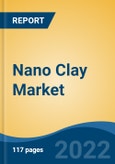Speak directly to the analyst to clarify any post sales queries you may have.
10% Free customizationThis report comes with 10% free customization, enabling you to add data that meets your specific business needs.
Natural nano clays are recommended for many applications as bentonite is present in the compound, makings it suitable for agricultural or cosmetics industries. Alkaline activation is frequently used to boost the natural bentonites pre-existing capacity to swell in water for applications in the building, drilling, and foundry industries as well as the food sector. Government initiatives for sustainable development and usability are expected to drive the growth of global Nano Clay market during the forecast period.
Growing Demand from the Paints & Coatings Industry
The coating is largely employed for surface security. It protects from chemical, mechanical, and environmental risks by avoiding water, oil, or air penetration, chemical corrosion, UV infiltration, and electrical conduction. When Nano Clay is mixed with water based coatings, it can enhance the bonding and mechanical properties as it uses in the coating material. The opacity and thermal capacity of the material coated with Nano Clay increase. Hence, the final finishing on the material coating with Nano Clay has better results than another conventional coating. Hence, the excellent properties of the coating and the rising upward trend of the paint and coating market size due to the increase in demand from the automobile and construction sector lead to an increase in the demand for the global Nano Clay market.Rising Demand from the Aerospace and Automotive Sector
The multifunctional capabilities and recent development of nano clays have developed various applications in the aerospace, vehicle, and automotive industries. Due to fatigue resistance, impact resistance, delamination toughness, and self-repairing ability, Nano Clay has played an important role in the development of advanced & modern aircraft. The demand for a lightweight and tough material is growing in aerospace, vehicle, and automotive industries for reducing oil consumption and fastening vehicle speeds. Furthermore, clay nanocomposites have offered an affordable, high-performance alternative to titanium oxide that can be used as aviation fuel tanks. The global military aircraft and aerospace manufacturing market was amounted to approximately 255.8 billion U.S. dollars in 2021 and expected to rise as the economies recover from the pandemic and other factors. All these trends are expected to propel the demand for the Nano Clay market to grow in the forecasted year.Ongoing R&D for New Applications is Driving Growth
The rising demand for liquid Nano Clay in the agriculture sector is opening new markets in the future as the demand for more land for agriculture purposes is growing, especially in barren and desert land fields. It helps in water retention and maintaining nutrient level in the soil. After the treatment with nano clay, the land also gets secured from soil erosion by winds. According to United Nations Convention to Combat Desertification, every year an estimated around 24 billion tonnes of fertile soil is lost due to erosion which is equivalent to about 3.4 tonnes lost every year for every person on the planet. Globally around 3.2 billion people are affected by land degradation, especially the rural communities and small farmers. Thus, to prevent desertification and convert sandy deserts into fertile farms, Nano Clay is going to hold a significant share in the agriculture sector. In addition, the development of starch-based Nano Clay and other new application like drug delivery systems are expected to create lucrative opportunities for the growth of global Nano Clay market in the coming years.Market Segmentation
Global Nano Clay market is segmented based on type, application, region, and company. Based on type, the market is divided into montmorillonite, kaolinite, smectite, and others. Based on application, the market is divided into water treatment, food, and beverages packaging, automotive, biomedical, paints and coatings, and others. By region, the market can be categorized into North America, Europe, Asia Pacific, Middle East & Africa, and South America.Market Players
UBE Industries Ltd., Mineral Technologies Inc., RTP Co, Techmer PM LLC, Merck KGaA, Kowa Company Ltd, Sun Chemical Corp, Elementis Plc, Nanocor Inc, Cabot Corp. are some of the major market player in global Nano Clay market.Report Scope:
In this report, global Nano Clay market has been segmented into following categories, in addition to the industry trends which have also been detailed below:Global Nano Clay Market, By Type:
- Montmorillonite
- Kaolinite
- Smectite
- Others
Global Nano Clay Market, By Application:
- Water Treatment
- Food and Beverages Packaging
- Automotive
- Biomedical
- Paints and Coatings
- Others.
Global Nano Clay Market, By Region:
- North America
- United States
- Canada
- Mexico
- Europe
- Germany
- France
- United Kingdom
- Italy
- Spain
- Asia-Pacific
- China
- India
- Malaysia
- Australia
- Japan
- South America
- Brazil
- Argentina
- Colombia
- Middle East & Africa
- South Africa
- Saudi Arabia
- UAE
Competitive Landscape
Company Profiles: Detailed analysis of the major companies present in global Nano Clay market.Available Customizations:
With the given market data, the publisher offers customizations according to a company’s specific needs.This product will be delivered within 1-3 business days.
Table of Contents
Companies Mentioned
- UBE Industries Ltd.
- Mineral Technologies Inc.
- RTP Co
- Techmer PM LLC
- Merck KGaA
- Kowa Company Ltd
- Sun Chemical Corp
- Elementis Plc
- Nanocor Inc
- Cabot Corp.








